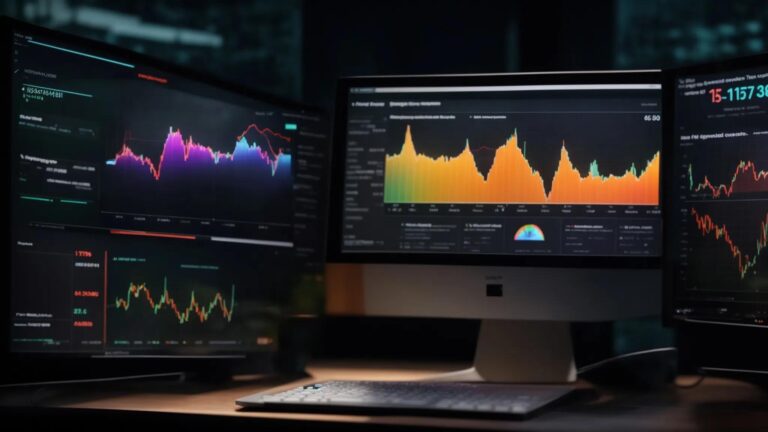Heads Up: When you purchase through links on our site, we may earn an affiliate commission at no cost to you.
Bounce rate is more than just a vanity metric—it’s a direct signal that something on your realtor property pages isn’t working. When someone visits your real estate site, views a single landing page, and leaves without engaging further, it triggers a bounce. For real estate agents, that means lost leads, wasted advertising spending, and missed opportunities for lead generation.
Knowing how to reduce bounce rates on realtor property pages is critical in a competitive landscape shaped by search engine optimization (SEO), mobile-first browsing, and high buyer expectations.
Pages that load slowly lack responsive web design or fail to connect with the target audience can push potential clients away before they view a listing. When those pages rank poorly on the search engine results page (SERP), your visibility drops and your conversion rate optimization efforts fall flat.
This guide will walk you through a complete approach to fixing high bounce rates. From optimizing your mobile device experience to leveraging Google Analytics, crafting persuasive call-to-action buttons, and improving accessibility and technical site architecture, every layer matters. Let’s explore the key factors and proven strategies for keeping users on the page, increasing lead flow, and generating real results for your real estate business.
Key Takeaways
- High bounce rates mean lost leads—optimize page speed, content, and structure to keep users engaged.
- Use responsive web design, accessibility, and intuitive navigation to improve user flow.
- Visual elements like virtual tours, photography, and interactive tools keep buyers on-page longer.
- Capture leads with smart CTAs, optimized forms, and automated CRM workflows.
- Use tools like Google Analytics, Semrush, and Hotjar to track, test, and iterate continuously.
Crafting High-Converting Realtor Landing Pages

Your landing page is the digital front door to your real estate business—and first impressions matter. If your page doesn’t load fast, speak clearly to your target market, or guide visitors toward the next step, you’re handing conversions to your competitors.
Optimizing these pages can dramatically reduce bounce rates on realtor property pages. Here’s how to create a successful one.
Optimize for Speed and Responsive Web Design
Speed is a deal-breaker. Today’s home buyers don’t wait around for slow-loading property listings, especially on a mobile device.
Checklist for Fast-Loading Pages
| Element | Optimization Tip | Related Tool/Tech |
|---|---|---|
| Images | Compress with next-gen formats like WebP | WordPress + plugins like Smush |
| Scripts and Styles | Minimize and defer loading | Use asynchronous JS & minified CSS |
| Hosting & Server | Use fast, reliable hosting | Cloudflare CDN |
| Caching & Delivery | Enable browser caching | Content Delivery Network (CDN) |
Optimized pages also need to look and function well across devices. Responsive web design and testing on smartphones, tablets, and desktops ensure consistent user interaction.
Design Elements That Drive Action
A good layout does more than look pretty—it guides behavior.
- Hero section: High-resolution photography showcasing real properties
- Call to Action (CTA): Above the fold, with active language like “Schedule a Tour” or “Get Pre-Approved”
- Contact options: Display your telephone number, email address, or chatbot for quick responses
- Trust indicators: Logos of insurance providers, realtor certifications, or National Association of Realtors badges
- Branding: Consistent use of your logo, color palette, and value proposition
H4: Don’t Neglect the Psychology of Your Copywriting
What you say—and how you say it—matters. Great copy reduces bounce by building credibility, establishing trust, and inspiring action.
Key elements of high-converting messaging:
- Address pain points: Use phrases like “Stop wasting time on listings that don’t match your budget”
- Show benefits: Highlight features like virtual reality walkthroughs or access to exclusive listings
- Use power words: Create urgency with phrases like “limited time offer,” “new on the market,” or “pre-launch opportunity”
Also, maintaining accessibility by using proper header structure (H1–H4), alt tags, and readable font sizes improves the user experience for everyone, including those using screen readers.
Content Structure and Flow Matter
A chaotic layout forces users to work too hard—and they bounce. Organize your content to support the journey from arrival to conversion.
Ideal Flow:
- Headline: Clear and relevant to the search query
- Subheadline: Reinforce benefit or promise
- Property images + testimonials
- Neighborhood data + map location
- Mortgage Calculator or financing options
- Lead capture form or appointment scheduler
Insert infographics or small comparison tables (e.g., property types, price ranges, neighborhoods) to add clarity. These keep users engaged and increase dwell time—a positive signal for the search engine algorithm.
Integrate Data and Tools for Decision Confidence
Buyers love transparency and control. Offer tools that give them value right away:
- Interactive mortgage tools: Help buyers calculate payments
- Local market snapshots: Use real estate trends, sales data, and pricing comparisons
- Lead magnets: Offer downloadable property guides or market analysis reports in exchange for their email address
Tools like HubSpot, custom dashboards, and CRM integrations help collect, manage, and segment leads for personalized follow-ups.
Mistakes to Avoid on Property Landing Pages
A few missteps can kill engagement instantly:
- Using auto-playing videos or music
- Cluttered navigation or multiple CTAs
- Uncompressed images that slow load time
- No clear value proposition or brand identity
- Neglecting mobile usability and content formatting
Remember, if users get confused or overwhelmed, they’ll hit the back button—and increase your bounce rate.
When you design landing pages with speed, clarity, relevance, and trust in mind, you’re not just making things look better—you’re optimizing for better customer experience, stronger lead generation, and better positioning on the search engine results page.
Boosting User Engagement Through Personalization and Relevance

Getting users to your real estate website is one thing. Keeping them there—and converting them—is another. The secret? Personalization and relevance. By using behavioral data, tailored content, and dynamic messaging, you can drastically reduce bounce rates and improve your lead generation funnel.
Understand User Behavior First
Before you can personalize, you need to understand how visitors behave. Start by using:
- Google Analytics for real-time data, bounce rate by page, session duration, and traffic sources
- Heatmaps and click tracking tools to uncover navigation friction
- Customer relationship management (CRM) platforms like HubSpot to analyze lead behavior, email open rates, and content interactions
- Behavior-based segmentation (e.g., users searching for “condos under $400k” vs. “luxury homes in suburban areas”)
With proper data analysis, you can deliver the right experience to the right target audience at the right time.
Use CRM and Automation for Smart Segmentation
Here’s where tech meets psychology. By syncing your email marketing, website, and CRM platforms, you can serve hyper-relevant content that speaks directly to your users.
Segmentation Criteria:
| Criteria | Example Personalization |
|---|---|
| Location | Show listings based on the user’s ZIP code or city |
| Search behavior | Display homes similar to previous views |
| Buyer type | First-time buyer tips vs. real estate investor info |
| Device type | Optimize layout for mobile device or desktop |
| Referral source | Adjust messaging for users from Google Ads or email newsletters |
Create Smart, Dynamic Content Experiences
Use content marketing to create flexible page experiences based on user needs:
- Serve curated virtual tours based on their saved listings
- Embed infographics explaining mortgage options or real estate market trends
- Customize CTAs like “See starter homes in your area” vs. “Explore luxury listings near downtown”
- Highlight testimonials or case studies from clients who match the user’s profile
- Offer access to a dashboard with saved listings, viewing history, and favorite neighborhoods
When visitors feel like your site was designed “just for them,” their trust builds—and the bounce rate drops.
Personalized Emails and Follow-Ups That Convert
Your email marketing should follow the same logic:
- Don’t blast the same content to everyone. Use segmentation, automation, and AI to tailor your messages
- Offer market analysis or recent listing updates for users who interacted but didn’t convert
- Use retargeting ads across social media marketing platforms with dynamic listing displays
- Measure impact using metrics like click-through rates, email open rates, and bounce rate per campaign
Platforms like HubSpot, Mailchimp, and Zoho CRM allow you to automate follow-up without losing the human touch.
Integrate Social Proof and User-Generated Content
People trust people more than they trust brands. That’s why social proof is a powerful bounce-rate buster.
Examples of Social Proof:
- Verified testimonials from recent home buyers
- Video walkthroughs or tours recorded by clients
- Highlighted stats: “Over 300 families helped in 2024”
- Embedded Google Business Profile reviews and ratings
- Showcase recent sales with notes like “Sold in 7 days” or “Received 3 offers in 24 hours”
Social proof creates confidence and can tip the scale for undecided users.
Don’t Ignore Personalization for Return Visitors
Use cookies, user accounts, or saved searches to recognize returning visitors. Greet them with:
- “Welcome back, here are your saved listings”
- Updated local search results based on their previous interest
- Suggested blogs on mortgage prep, moving tips, or interior design trends
- Content-based on demographic preferences (e.g., first-time buyers, real estate investors, or downsizers)
Personalization is no longer optional, especially in real estate, where decisions are emotional, high-stakes, and time-sensitive. Technology, automation, and behavioral analytics can help you tailor every interaction and make every visit count.
Enhancing Trust and Credibility to Retain Visitors
Once a potential buyer or seller lands on your real estate website, their next question is: Can I trust this agent or platform with such a big decision? If your site feels sketchy, outdated, or lacks validation, they’ll bounce—fast.
This section focuses on building credibility, increasing user confidence, and reinforcing your brand—all key factors in helping you reduce bounce rates on realtor property pages.
H3: First Impressions and Visual Credibility
Design still matters. Users judge your site in milliseconds. If it looks unprofessional or inconsistent, they’ll assume the same about your real estate services.
Must-Have Visual Elements:
- High-resolution images of properties, not just thumbnails
- Branded color palette and cohesive web design
- A clean navigation bar with visible contact info and CTA buttons
- Prominent logo, tagline, and value proposition
- Trust signals like SSL certificates, professional headshots, and broker affiliations
Even your font, menu layout, and button design influence trust and improve the user interface.
H3: Use Trust-Building Content Formats
Content isn’t just for SEO—it also communicates legitimacy.
- Video testimonials from satisfied clients
- Verified badges like “Member of the National Association of Realtors” or “Top 1% Local Agent”
- Case studies showing real lead generation success stories
- Infographics explaining the home buying process or mortgage steps
- Client logos or real estate trends data backed by credible sources
Also include community highlights, suburb profiles, or neighborhood stats to position yourself as a local expert.
H3: Transparency Tools for Added Confidence
Want users to stick around? Be transparent about pricing, services, and expectations.
Trust-Building Tools to Add:
| Tool / Feature | Purpose |
|---|---|
| Mortgage calculator | Helps with budget planning and financial trust |
| Live chat or chatbot | Offers instant answers and builds connection |
| Clickable map search | Adds interactivity and credibility |
| Clear fees page | Avoids surprises and aligns expectations |
| Customer service phone number | Humanizes your brand and offers real-time support |
Transparency reduces bounce rate by lowering anxiety and boosting decision-making confidence.
Display Your Reputation Everywhere
People rely on online reviews now more than ever. Make it easy for visitors to find and trust your reviews.
- Embed Google Business Profile reviews
- Add a rotating testimonial slider on property pages
- Link to your Facebook, Zillow, or Yelp reviews
- Highlight review averages: “4.9 stars from 130+ buyers”
- Display recent client success stories and closings with images
Also, mention how your site respects user privacy, complies with relevant policies, and uses trusted software and data protection practices.
Create a Secure, Professional Environment
Security is part of trust. Visitors need to know your site is safe.
- Use HTTPS and display a visible padlock icon
- Include privacy policy, terms of use, and cookie notices
- Protect forms with reCAPTCHA to avoid spam
- Ensure accessibility for all users
- Conduct a regular site audit to identify outdated plugins or design flaws
Having a solid architecture, an organized site map, and minimal duplicate content also helps your SEO while boosting trust.
Bonus Trust Signals That Matter
- Listing on reputable directories like IDX Broker or Realtor.com
- Profiles on LinkedIn, Trulia, or local chamber of commerce sites
- Sharing helpful blog posts, newsletters, or market insights
- Including certifications or continuing education badges
- Providing downloadable resources: PDF guides, eBooks, community maps
Trust isn’t a single tactic—it’s the result of combining visual consistency, functional reliability, social proof, and transparency. Once that trust is earned, users are far more likely to stay, engage, and convert.
Speed, Accessibility, and Technical SEO Fixes

No matter how polished your site looks, if it’s slow or glitchy, users won’t stick around. Technical issues are a major cause of high bounce rates, especially for real estate websites with heavy image files, third-party plugins, and outdated frameworks. This section covers the must-fix technical elements to reduce bounce rates on realtor property pages—while also boosting your SEO and user satisfaction.
Optimize Page Speed with Technical Precision
Speed isn’t just about convenience—it’s a core ranking factor on the search engine results page. A one-second delay in load time can cost you leads, especially on a mobile device.
Here’s what to optimize:
- Content Delivery Network (CDN): Distribute content quickly across regions
- Image compression: Convert high-res property images to WebP or JPEG 2000 formats
- Enable browser caching and minify JavaScript for faster repeat visits
- Lazy loading: Defer offscreen images and video tours
- Use Google PageSpeed Insights, Semrush, or GTmetrix to audit performance
Most real estate agent websites also integrate with platforms like IDX Broker, which may affect load times—ensure you’re caching or optimizing those data feeds.
Improve Accessibility and Compliance
Accessibility isn’t just a legal obligation—it also keeps users from bouncing. Make your real estate site easy to use for everyone, including those with visual or motor impairments.
- Use proper HTML semantic tags (like <main>, <nav>, <footer>)
- Add alt attributes to all listing images, floor plans, and virtual tours
- Ensure color contrast and readable font sizes
- Enable keyboard navigation and screen reader support
- Use tools like axe DevTools, WAVE, and SiteImprove to test compliance
Improving accessibility boosts user experience, helps with SEO, and can even improve your standing in Google’s algorithm.
Fix Broken Links, Redirect Loops, and Duplicate Content
These are silent killers of both user trust and search engine optimization.
- Run regular site audits to identify broken URLs
- Fix or remove redirect chains, 404 errors, and unnecessary forwarding
- Use canonical tags to solve duplicate content from MLS or IDX
- Keep your sitemap.xml and robots.txt updated and submitted in Google Search Console
Don’t forget: your navigation, menu, and footer links must be accurate. A broken call to action button or a looped redirect on a “Contact Us” page can destroy credibility instantly.
Speed and Tech Checklist for Realtor Sites
| Fix Type | Tool/Platform Used | Result |
|---|---|---|
| Load Speed | Cloudflare, WP Rocket | Lower bounce rate, improved SEO |
| Mobile Optimization | Google Mobile Test | Better UX on smartphones/tablets |
| Caching | WP Fastest Cache, LiteSpeed | Faster page load and return visits |
| Duplicate Control | Yoast SEO, Screaming Frog | Reduced penalties from Google |
| Analytics Tracking | Google Analytics, Hotjar | Insight into bounce-related behaviors |
Optimize for Mobile and Emerging Technologies
With most real estate leads coming from mobile, your site must be optimized for mobile web and responsive across devices.
- Ensure listings load properly on smartphones.
- Minimize tap targets and simplify navigation menus.
- Use mobile-friendly popups or slide-ins for lead capture.
- Integrate voice search compatibility with schema markup and long-tail keywords.
Modern users expect mobile-first design—fail here, and even your best ads won’t convert.
Don’t Forget Security and Trust Signals
Tech issues aren’t just about load speed—they also include safety.
- Secure your site with HTTPS
- Display your SSL certificate in the address bar
- Avoid insecure plugins that slow down or compromise the site
- Clearly state your privacy policy, cookie policy, and data protection measures
Secure, fast-loading sites with clean architecture and strong technical SEO create a smooth, trustworthy experience. This leads to lower bounce rates and longer session durations—both gold for your digital marketing ROI.
Smart Navigation, Architecture, and Search Experience

Navigation can make or break a user’s journey. If people can’t find what they’re looking for in two or three clicks, they’re gone—and your bounce rate climbs. For realtor property pages, navigation needs to be intuitive, fast, and designed to support lead generation and conversion rate optimization.
Build a Clear, Logical Site Architecture
A strong site architecture improves user experience, supports search engine indexing, and allows users to move from one landing page to another with minimal friction.
Best Practices for Realtor Site Structure:
- Use breadcrumb navigation so users always know where they are
- Group listings by location, property type, and price
- Maintain a clean URL structure (e.g., yoursite.com/properties/miami-condos)
- Keep your navigation menu uncluttered with essential items like “Buy,” “Sell,” “Blog,” “Contact,” and “Favorites”
- Include a visible site search bar that accepts long-tail keywords like “3-bedroom homes with pool in Phoenix”
Clear architecture also supports internal linking for better SEO, helping Google crawl and understand your site structure.
Enhance the Search and Filtering Experience
Smart search keeps users engaged by letting them control how they explore your content.
Key Features to Include:
- Autocomplete suggestions to speed up searches
- Search by ZIP code, property size, or feature (e.g., pool, garage, virtual tour)
- Advanced filters for price, bedrooms, bathrooms, or even Walk Score
- Custom sorting for newest listings, open houses, or foreclosures
- Integrate predictive analytics to display relevant listings based on user behavior
Providing intuitive filters and personalized results increases time on site, interaction rate, and ultimately leads.
Create Touchpoints that Support Every Buyer Journey
Navigation isn’t just about moving from page to page—it’s about guiding users through their journey.
| Buyer Stage | Navigation Focus | Example |
|---|---|---|
| Awareness | Informative blog posts, neighborhood guides | “Top 10 communities for families in Miami” |
| Consideration | Interactive tools and calculators | “Estimate your monthly mortgage” |
| Decision | Contact forms, CTAs, virtual tour booking | “Schedule a property tour today” |
Each stage needs different types of content marketing, calls to action, and lead capture mechanisms. Proper navigation keeps buyers on the right path.
Make It Mobile First and ADA-Compliant
Navigation has to work seamlessly on mobile devices and meet accessibility guidelines.
- Use hamburger menus for smaller screens
- Place contact buttons and CTA forms at thumb-friendly locations
- Add ARIA labels for screen readers
- Ensure logical tabbing order and keyboard accessibility
A mobile-friendly navigation structure that meets ADA compliance isn’t just inclusive—it improves rankings and reduces user frustration.
Tools to Audit and Improve Navigation
| Tool | What It Fixes |
|---|---|
| Hotjar or Crazy Egg | Tracks user scroll and click behavior |
| Screaming Frog SEO | Identifies broken links and crawl issues |
| Google Search Console | Reports mobile usability and site errors |
| Yoast SEO Plugin | Improves page hierarchy and internal links |
Regular audit of your site’s navigation ensures that it aligns with search engine optimization best practices and continues to support a positive user experience.
Efficient navigation isn’t just UX—it’s strategy. When you help people find exactly what they need, bounce rates drop, leads increase, and your real estate SEO benefits long-term.
Using Visuals, Virtual Tours, and Content to Keep Users on the Page

People shop with their eyes—especially in real estate. An image-heavy listing with the right virtual tour, visuals, and supplemental content doesn’t just impress—it keeps visitors from bouncing. This section explores how smart visual content design drives user engagement and boosts your on-page performance.
Leverage High-Impact Visuals to Maximize Attention
Good visuals can instantly increase time on site, decrease bounce rate, and communicate more than paragraphs of text ever could.
Must-haves for every property page:
- High-resolution photography with attention to detail (interior and exterior shots)
- Video walkthroughs showing layout, space, and flow
- Virtual staging to help buyers visualize the potential
- Before-and-after shots to showcase renovations or upgrades
- 360-degree tours using platforms like Matterport, especially for luxury properties or commercial spaces
Every image should include relevant alt text to support accessibility and strengthen your SEO strategy.
Offer Virtual and Augmented Reality Tours
If your site still only shows flat images, you’re falling behind. Today’s home buyers want immersive, real-time experiences.
Virtual reality (VR) and augmented reality (AR) tools allow potential buyers to:
- Walk through a listing from their couch
- Visualize furnishings with AR overlays
- Navigate homes on smartphones, tablets, or desktops
- Compare properties without traveling or scheduling in-person visits
- Explore commercial properties and condominiums remotely
The result? Increased engagement, reduced bounce, and higher lead conversion. Use this content across your landing pages, social media marketing, and even in email campaigns.
Support with Contextual, Keyword-Rich Descriptions
Every visual asset should be supported by engaging, informative content. Don’t just say “3-bedroom home”—explain what makes it stand out.
Example Description Block:
This 3-bedroom smart home in Phoenix features an energy-efficient design, an oversized backyard, and proximity to top-rated schools. Schedule a virtual tour today or view it on your mobile device for an interactive walk-through.
Use keyword research tools like Semrush or Google Search Console to guide phrasing. Include long-tail keywords to better match user intent, improve relevance, and surface on the search engine results page.
Reinforce Content with Downloadables and Interactive Tools
Supplement visuals with downloadable and interactive assets:
- PDF guides: “Complete Home Buying Checklist”
- Infographics showing local trends, mortgage rates, or market movement
- Interactive calculators for estimated payments, renovation costs, or down payments
- Local area guides with map pins, walkability, public transport, and school ratings
- Shareable content: create graphics users can repost on social media
Adding these tools increases engagement, generates leads, and encourages content sharing, which indirectly supports link-building and backlinks.
Content Placement and Layout: Above the Fold Matters
Always think about layout. Your most compelling content should be above the fold (visible without scrolling), especially on mobile devices.
Key elements to include in this zone:
- Main image carousel
- Prominent call to action (e.g., “Book a Tour” or “Request Info”)
- Basic property specs: price, size, location
- Scroll prompt or arrow encouraging continued interaction
Below the fold, insert sections like:
- Testimonials or recent customer satisfaction stories
- Social proof from Google Business Profile reviews
- Related property suggestions (to keep users on your site longer)
Optimize Visual Elements for Speed and SEO
While visuals drive engagement, they can also slow your site down—unless you optimize:
| Visual Asset | Optimization Best Practice |
|---|---|
| Photos | Use compressed formats like WebP |
| Videos | Embed from YouTube or Vimeo |
| 3D Tours | Load asynchronously to improve speed |
| Infographics | Use descriptive file names and alt text |
| Slideshows | Limit autoplay and reduce file size |
This ensures your web page doesn’t lag or frustrate visitors on the mobile web or have slower internet connections, reducing bounce rate and boosting user experience.
Visuals are no longer optional. They’re part of your conversion strategy, branding, and ability to communicate value in seconds. Combine them with a smart layout, strong messaging, and lightning-fast load speeds, and you’ll keep more users engaged longer.
Nurture and Convert: How to Capture and Retain Realtor Leads

You’ve reduced your bounce rate—now it’s time to convert traffic into action. High-performing realtor property pages don’t just attract eyeballs; they capture leads, deliver value, and guide users toward decision-making. This section covers proven strategies to keep users engaged and move them through your conversion funnel.
Strategic CTAs That Match User Intent
The call to action (CTA) is your most powerful conversion element—but it must align with the visitor’s mindset.
Effective CTA Examples:
- “Get Instant Access to This Listing”
- “Schedule a Virtual Tour”
- “Compare Mortgage Rates Now”
- “Download Our Local Market Guide”
- “View Similar Properties in Your Budget”
Position CTAs at natural breakpoints—after a testimonial, in the sidebar, or beside a virtual tour. Use contrasting colors, concise wording, and above-the-fold placement to capture attention.
Offer Lead Magnets That Actually Provide Value
You can’t just say “Contact Us” and expect leads to flood in. Offer something in return.
High-Converting Lead Magnets:
| Lead Magnet Type | Purpose and Example |
|---|---|
| Newsletter signup | “Weekly listings in your favorite neighborhoods” |
| Ebooks/PDFs | “2025 Homebuyer Checklist” or “Local Area Guide” |
| Email drip series | “5-Day Crash Course: Understanding Mortgages” |
| Free CMA tool | “Find Your Property’s Value in 60 Seconds” |
| Loan calculator | Estimate down payments, mortgage, and ROI |
Connect every magnet to keyword research and the behavior of the target audience. Use analytics tools like Google Analytics, HubSpot, or Semrush to track what resonates.
Use CRM and Automation to Guide the Journey
Capturing a lead is just the beginning. Customer relationship management (CRM) software can help you track, tag, and nurture users over time.
Recommended CRM Features:
- Email sequences based on behavior (opens, clicks, time on page)
- Lead scoring based on interaction and property interest
- Integration with IDX Broker or MLS feeds
- Smart segmentation: first-time buyers, real estate investors, downsizers, etc.
- Automated follow-ups with listing updates or event invites
Popular CRMs, such as HubSpot, Zoho, or LionDesk, offer seamless integration with landing pages, email marketing, and real estate websites.
Add Live Chat, Chatbots, and Instant Messaging
Speed matters. A visitor with questions won’t wait to fill out a form—they’ll leave. Use tools like LiveChat, Intercom, or AI-powered chatbots to handle inquiries in real-time.
Use chat to:
- Offer instant booking for tours
- Answer FAQs about listings or mortgage options
- Provide recommendations based on user behavior
- Collect email addresses or phone numbers for follow-up
- Qualify leads instantly and send them to a real estate agent
This improves user experience, boosts conversion rate, and helps reduce the bounce rate on high-traffic pages.
Make Forms Easy, Short, and Mobile-Friendly
Nobody likes long forms—especially not on a smartphone.
Best Form Practices:
- Use only 3–5 fields (Name, Email, Phone, Buying/Selling)
- Include social proof or trust badges near the form
- Add a compelling headline like “Talk to a Local Expert Today”
- Optimize the form with auto-fill, mobile responsive layout, and simple UI
- Always include a privacy statement or link to your data policy
Form placement matters, too—embed within property pages, blog posts, or sticky headers as needed.
Capturing leads is about empathy and experience. When users feel understood, guided, and supported by relevant tools, personalized content, and seamless technology, they don’t just stay—they convert.
Measuring and Iterating: Using Analytics to Fine-Tune Your Strategy

You can’t improve what you don’t track. If you want to consistently reduce bounce rates on realtor property pages, you need to analyze the data, understand user behavior, and continuously iterate. This final section focuses on the tools, metrics, and adjustments needed to make smarter, faster improvements.
Know Which Metrics Matter Most
Not all metrics are created equal. Focusing on vanity metrics like page views without context will mislead your strategy.
Instead, monitor these essential KPIs:
| Metric | Why It Matters |
|---|---|
| Bounce Rate | Measures how many users leave after one interaction |
| Average Time on Page | Indicates engagement and content relevance |
| Click-Through Rate (CTR) | Tracks how well CTAs or listing links convert |
| Scroll Depth | Helps identify where visitors lose interest |
| Conversion Rate | The most important indicator of lead quality |
| Traffic Source | Shows which channels (SEO, social, ads) drive quality traffic |
| Exit Pages | Reveals which pages most often end user sessions |
Pair these with real estate-specific goals, such as showing the number of users who sign up for listing alerts, schedule a virtual tour, or submit a mortgage pre-qualification form.
Use the Right Tools for Deep Insights
Don’t rely solely on Google Analytics. Use a combination of tools to get a holistic view of your site’s performance.
Analytics and Optimization Toolkit:
- Google Analytics 4: Tracks user engagement, behavior flow, and bounce rate
- Google Search Console: Monitors search engine visibility, queries, and index issues
- Hotjar or Microsoft Clarity: Heatmaps, scrollmaps, session recordings
- Yoast SEO or Rank Math: SEO diagnostics and content performance
- HubSpot: End-to-end tracking from visitor to lead conversion
- Semrush: Tracks keywords, backlinks, and technical SEO health
- Ahrefs or Moz: Competitive benchmarking and link-building analysis
These platforms help you identify friction points, such as site speed, broken landing pages, or poor content strategy.
Segment and Personalize Based on Behavior
Generic insights aren’t enough. Segment users by behavior, device, and intent.
- Mobile vs. Desktop: Check if your responsive web design works equally well on all screen sizes
- New vs. Returning Visitors: Adjust CTAs and content for each group
- Traffic Channels: Tailor landing pages for Google Ads, email campaigns, or social media
- Target Market Segmentation: Buyers vs. sellers, investors vs. first-timers
Use this to create personalized experiences and reduce friction, which directly impacts user experience, time on site, and conversion rate optimization.
A/B Test and Iterate Regularly
No page should be static. Realtor websites need to evolve with changing search engine algorithms, trends, and user expectations.
Elements to A/B Test:
- Headlines and CTA button text
- Placement of property details or virtual tour links
- Testimonial location and format
- Layouts on high-bounce pages
- Form length and placement
- Use of infographics vs. bullet summaries
- Navigation structure and site map arrangement
Document every change and track the impact on bounce rate, leads, and user feedback.
The best-performing real estate websites never stop improving. With the right tools, analysis, and a clear understanding of your target audience, you can turn site visitors into clients and high bounce rates into high-converting assets.
Frequently Asked Questions
What is a good bounce rate for a real estate website?
Typically, 40–60% is considered average. Anything higher means users are likely not finding what they need and leaving too soon.
How do visuals help reduce bounce rates?
High-quality images, virtual tours, and videos improve engagement and time on-site, giving users reasons to explore more listings.
Can mobile performance affect bounce rate?
Absolutely. A slow or clunky mobile experience is a leading cause of high bounce—make sure your site is responsive and fast.
How often should I audit my site for issues?
At least once per quarter. Regular site audits catch broken links, outdated content, and technical SEO issues that drive users away.
What tools help track bounce rate?
Measure, analyze, and improve bounce-related performance using Google Analytics, Search Console, Hotjar, and HubSpot.
Conclusion
Reducing bounce rates on your realtor property pages isn’t just a technical fix—it’s a strategic move to increase engagement, generate more leads, and build stronger relationships with your target audience. From improving page speed and optimizing site structure to leveraging visual content, smart CTAs, and ongoing analytics, every adjustment you make creates a better experience for both users and search engines.
Ready to boost your visibility, credibility, and conversions? Fill out our quick form to get a cash offer for your next SEO strategy—no hidden fees, no waiting, just a fair, hassle-free solution for scaling your real estate business.















